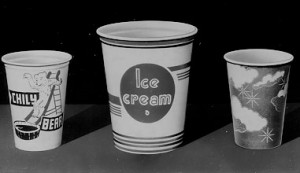Series VIII. Product Samples
Series VIII, Product Samples (1910-1986), contains a unique collection of Dixie products. There are approximately two-thousand paper cups and containers in various sizes, of which half remain in their original carton, dispenser, or cellophane-wrapped retail packaging. While the bulk of these products were manufactured between the late 1920s and the 1950s at the Easton plant, there are samples of products made by the American Water Supply Co. of New England in 1910, the Individual Drinking Cup Company’s Health Kup after 1912, and samples of the first Dixie Cup manufactured in 1919. There are also items manufactured after the merger with American Can Company in 1957, and James River Corporation in 1982. The products are arranged chronologically in two subseries.

Subseries 1, Cups, contains samples of the earliest cups, which are arranged chronologically according to improvements in cup design; after 1926 the chronological arrangement of the cups is drawn from decorative patterns identified in illustrations in the company’s sales manuals and related publications (See Series IV). In addition to Dixie products this subseries also contains “Gem Cups” manufactured by Dixie’s competitor, the Lily-Tulip Corporation. The design of these cups was the subject of a law suit in the 1930s and is documented in Series III. There are also samples of the “Trophy Cup,” manufactured by the Vortex Cup Company prior to the merger in 1936. For samples of flat-folded cups sold by competitors see Series II.

The products in Subseries 2, Retail Packages, Dispensers, Miscellaneous, are arranged chronologically according to the year in which a packaging or dispensing product first appeared as identified in the printed material.
The American Water Supply Company developed a 5oz. paper cup, of a two-piece, flat-bottom construction, straight edged and “treated” (waxed). In approximately 1915 the design was improved to give the cup a raised disc bottom for proper spacing when nested in a dispenser. In 1919 another manufacturing innovation gave the cup even greater rigidity with the addition of the rolled brim. The disc bottom construction was improved with “upturned bottoms” in approximately 1921-1922. The earliest cups were almost exclusively white, not printed, but for several years, 1923- 1924, were embossed on the disc bottom, and then on the sidewalls. In 1924 the company also developed a waxing process to strengthen, or “treat” cups that were marketed as Soda cups. Cups made to hold water, and later hot drink cups continued to be “untreated.”
Beginning in 1923, the Individual Drinking Cup Company began to experiment with adapting the Dixie cup to ice cream. While their first attempts at filling cups with ice cream failed, they soon developed a sturdier cup, and a highly successful automatic filler machine, rebuilt in 1955. The first “seated” cups (a ridge was formed below the rim to fit a lid) appeared around 1925, and were developed to provide a proper container for ice cream. By 1930 the container market had become so popular, that the “PAC-KUP” container was added to the line.
The popular Ice Cream Dixies not only ushered in a very successful container market, but also introduced the first cups with decorated sidewalls. The first example of special-print cups had appeared in 1917, when Health Kups were printed for railroads and hotels. But Dixies became famous with the introduction of the Diamond Design for H.P. Hood’s “Hoodsies” ice cream containers in 1925, and Mill Run Scroll design in 1926. After 1928 all drink cups and containers were made with a decorative pattern printed on the sidewalls and new decorative patterns were developed almost every year.
At first the company introduced the Adam Period Design, also known as the “Decorated Dixie” on all Dixie Cups in 1928. To further improve the appearance of their product, Dixies were soon tinted in various colors. While the cups were sold in square paper cartons at first, the company realized that the sight of the colorful designs on store shelves could assist in retail sales. The card-board carton packaging was replaced, for the most part, with a cellophane wrap in 1931. The various decorative design patterns represented in this series include the Revised Adam Period design of 1931, a reduced version of the Original Adam Period Design, which appeared on the newly developed Hot Drink Dixie in 1933; the Modern Adam Period design which appeared in 1939, and the New Melody Design which replaced the Modern Adam Design in 1951 as the standard. (The Melody design was a collaborative effort of the Dixie Art and Research department and design consultants, Nowland & Schladermundt of New York. Correspondence regarding the development of the design can be found in Series I and IV).
There were also many designs which were developed to meet a variety of marketing needs. There was the Chily Bear design of 1933 for sherbet; the Reg’lar Fellers Design of 1933 for fruit ice, and the (Vortex) Take-Home Sundae design of 1936. Several designs were also developed which had a particular message, like the Safety First Design of 1939, and the Defend America series of 1941. In addition to cups of the two-piece construction, this series includes several cone-shape cups which became part of the product line after the merger with the Vortex Cup Company in 1936. In addition, dozens of special designs were sold for parties, picnics, and special occasions through the cellophane- wrapped “Package line.” These retail packages are well represented in this collection.
In 1949 the “Homeline” was introduced, a line of smaller cups, holders, and packaging to be used in kitchens and bathrooms. In 1950 the company finally succeeded in developing a specially treated cup for alcoholic beverages with the Brew Master Beer Dixie and the Mixie Dixie for cocktail drinks. The American Can Company introduced “Mira- Glaze” in 1959, a line of cups and dishes treated with a polyethylene lining which was laminated to the paper before forming, giving complete coverage and supposedly eliminating cardboard taste; the company also introduced a line of all- plastic cups in 1963.
